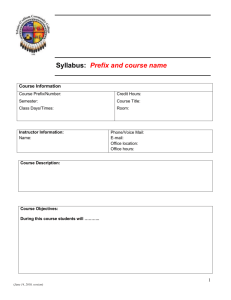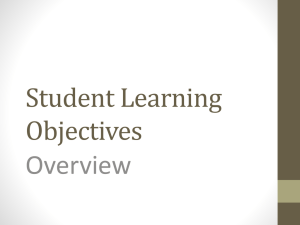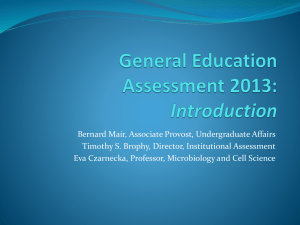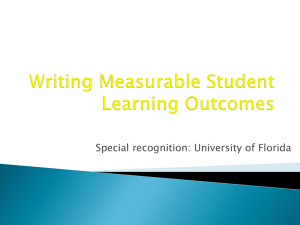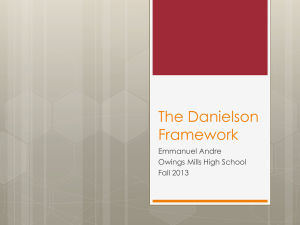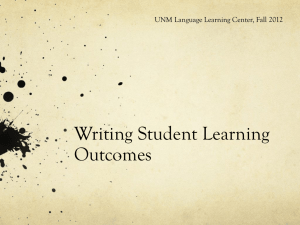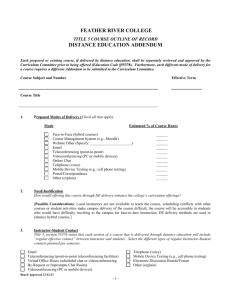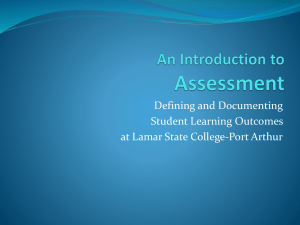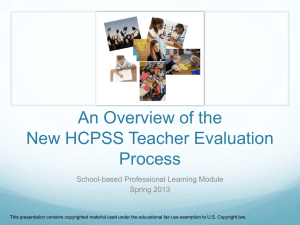Writing Course-Level Student Learning Outcomes
advertisement
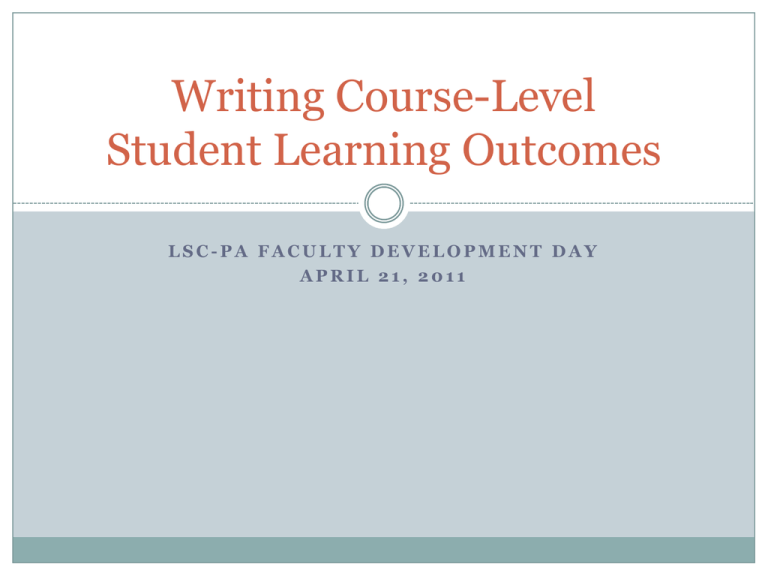
Writing Course-Level Student Learning Outcomes LSC-PA FACULTY DEVELOPMENT DAY APRIL 21, 2011 In Context This semester we have worked hard to create and support Program Student Learning Outcomes, and we have even worked on General Education/Core Curriculum Student Learning Outcomes. Now it’s time to move into Course-Level Student Learning Outcomes. Expected Learning Outcomes, Defined An expected learning outcome is a formal statement of what students are expected to learn in a course. Expected learning outcome statements refer to specific knowledge, practical skills, areas of professional development, attitudes, higher-order thinking skills, etc., that faculty member expect students to develop, learn, or master during a course (Suskie, 2004). Simply Stated Simply stated, expected learning outcome statements describe: What faculty members want students to know at the end of the course. and What faculty members want students to be able to do at the end of the course. Three Major Characteristics Learning outcomes have three major characteristics: They specify an action by the students that is observable. They specify an action by the students that is measurable. They specify an action that is done by the students (rather than by the faculty members). Effectively developed expected learning outcome statements should possess all three of these characteristics (Suskie, 2004) Tips for Developing Expected Student Learning Outcomes Limit the Course-level SLOs to 5-8 statements for the entire course. (More detailed, specific outcomes can be developed for individual units or assignments within the course.) Base the Course-level SLOs on the Program SLOs, which are derived from the Institutional Mission and Goals. Tips for Developing Expected Student Learning Outcomes Focus on knowledge and skills that are central to the course topic and/or discipline. Focus on overarching or general knowledge and/or skills, rather than on small, trivial details. Focus on the learning that results from the course rather than describing lessons or activities in the course. Tips for Developing Expected Student Learning Outcomes Create statements that are student-centered rather than faculty-centered. (“Upon completion of this course, students will be able to list the names of the 50 states” rather than “one objective of this course is to teach the names of the 50 states.”) Use active verbs from Bloom’s Taxonomy to start the Student Learning Outcome statements. Additional Considerations You might also want to consider the following questions as you consider your SLOs: Is this course required or an elective? Is the course required for some and elective for others? Does the course have a prerequisite or is it a prereq? Is this an introductory course or does it build on others? What is the value of taking this course? What do I want students to know in 5 years as a result of taking this course? Writing Effective Learning Outcome Statements When stating expected learning outcomes, it is important to use verbs that describe exactly what the learners will be able to do upon completion of the course. Use your Bloom’s Taxonomy list for help choosing verbs. Avoid beginning SLOs with vague verbs that are not measurable, such as know, be aware of, appreciate, learn, understand, comprehend, and become familiar with. Some Weak and Strong Examples Weak: The students will understand basic human development theory. Better: The students will be able to identify and describe two major theories of human development. Weak: The students will appreciate music from other cultures. Better: The students will be able to identify the characteristics of music from other cultures. Bloom’s Taxonomy, Redux Remember, Bloom’s Taxonomy identifies verbs for different levels of thinking skills. Some verbs indicate basic cognitive skills while others indicate complex, higher-order or critical thinking skills. Refer to your Bloom’s Taxonomy handout for ideas about which verbs to use as you write your SLOs. Also, refer to the handout entitled, “Anderson and Krathwohl’s Adaptation of Bloom’s Taxonomy” for definitions of different levels of thinking skills. Assessing SLOs As you create or re-create your classes for next semester, be sure to keep in mind both the Courselevel Student Learning Outcomes and the Program Student Learning Outcomes. You want to be sure to include formal evaluation or assessment of the SLOs throughout the semester. Assessing SLOs Some formal evaluation or assessment techniques: - Exams - Quizzes - Papers/Essays - Homework - In-Class Activities - Graded Class Discussions Some informal evaluation or assessment techniques: - Non-Graded Quizzes - Active Learning Techniques - Polling/Surveying - Personal Response Journals Extra credit activities should not be used for assessment. More Than SLOs It is important that you realize that your course may include material that does not necessarily meet any formal student learning outcome. In other words, you can include material in your course, on your tests, in your assignments, and in your presentation of information that is not covered by an SLO. You just need to ensure that you present material that is covered by the SLOs. Intentional Instruction As you write or re-write your exams, assignments, homework, or other activities, be sure to keep the Student Learning Outcomes in mind. Create new assignments to produce outcomes as needed. Revise old assignments to produce outcomes. Be intentional in delivering material that leads to the desired outcomes. What To Do Today: We will create the SLOs for one course. If more than one faculty member teaches the course, you should get together and come up with common SLOs. Before the Semester Ends: You should create the SLOs for each of the classes you will be teaching in the summer or fall. Before Your Next Teaching Semester: You should determine how your assignments and exams measure the SLOS (TEST and PROJECT MAPS!!!). Send ‘Em In Before your next teaching semester: Send David a PRINT (word-processed) copy of your Course-Level Student Learning Outcomes. Just have them put into his campus mailbox. If more than one person teaches the course, send only one copy with everyone’s name on it. Do NOT email copies. Print copies only, please. Include In Your Syllabus In your syllabus for summer, fall, and forward, please include: The applicable Program Student Learning Outcomes The Course-Level Student Learning Outcomes That’s All, Folks!
